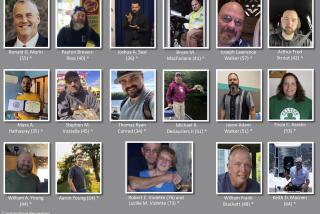NASA Chief Takes On Critics
As the crew of the slightly damaged orbiter Discovery began preparations Friday to undock from the International Space Station, NASA Administrator Michael D. Griffin defended the shuttle mission, calling it one of the cleanest on record.
“It’s been a magnificent flight,” Griffin said during an appearance with Texas legislators at the Johnson Space Center. “I don’t know what people could want that they haven’t seen.”
He said critics had fixated on the flight’s flaws, such as insulating foam shedding from the craft’s external fuel tank during liftoff and the need for a first-ever spacewalk to remove protrusions on the underside of Discovery.
Not only do critics see a glass half-empty, but, to them, “there is no glass,” Griffin said.
He said the crew had accomplished everything it set out to do -- replacing a faulty gyroscope on the space station, repairing a second one and delivering 12,107 pounds of water, equipment and food.
Just as crucial for the crowded, half-built space station, Discovery will return home with 7,055 pounds of trash and broken machinery.
“The crew has done a huge amount,” Griffin said.
On Friday, the astronauts finished returning the Italian-made storage bin that had brought the supplies back into Discovery’s payload bay. They also stowed the new 50-foot boom sensor arm that allowed astronauts to inspect Discovery’s heat protection system while it was docked.
Today, the orbiter is to undock from the space station to begin the flight home to Kennedy Space Center in Florida. The craft is due to land early Monday.
Yet the crew isn’t completely out of the woods. NASA elected not to fix a torn and bulging piece of insulation blanket under the cockpit window that might have been struck by debris during launch.
Although engineers said a piece of the blanket could come off and hit the orbiter during the intense aerodynamics of reentering Earth’s atmosphere, they called the possibility remote.
Two spouses of Discovery’s crew said Friday they understood that risks remained for the Discovery crew, which was the first to launch into space since the loss of Columbia in 2003.
But Discovery Cmdr. Eileen Collins’ husband, Pat Youngs, and mission specialist Charles Camarda’s wife, Melinda, said they believed NASA had done everything possible to make the landing safe.
“It’s been a roller coaster with all the different issues popping up,” said Youngs, 47. “I’ve been very pleased with how they’ve ... resolved them.
“Eileen is very comfortable with” the situation, he added. “Everything I’ve gotten from her is very positive.”
Melinda Camarda said: “I personally feel they’ve had more ups than down.” At the same time, she said, she has not encouraged her four children to watch news about the flight’s problems.
“We don’t put them in front of the TV,” she said.
Youngs said his two children pray every night for the crew’s safety.
After the flight, he said, he plans to take his wife to Hawaii. Collins, however, seems to be thinking more about food. She can’t wait to go out for Mexican food, Youngs said. “She’s an enchilada fan.”
Discovery’s flight has suffered a number of glitches, beginning with the foam shedding on launch that caused NASA to ground the shuttle fleet until it could make sure no more large foam pieces would come off. Columbia was doomed by a piece of foam that struck and tore a hole in its left wing.
A NASA team is looking into the problem. Griffin said the foam problem might be insoluble since pieces had been coming off the external tank for 20 years or more. But he said he thought NASA’s engineers could at least reduce the amount of foam coming off enough so that the shuttle could finish building the space station over the next five years.
A number of critics have criticized the space agency over the problems. Griffin said too many people were focusing on the wrong things.
“This shuttle is in as good a shape as any we’ve had,” he said. He pointed out earlier that the heat-resistant tiles had suffered about one-sixth the number of dings and divots as the average shuttle flight.
The comparison isn’t exact, however, because the hits to the tiles on previous flights were measured after landing.
Griffin also met Friday with Sen. Kay Bailey Hutchison (R-Texas), chairwoman of the Senate subcommittee on science and space, and House Majority Leader Tom DeLay (R-Texas).
Both pledged to make sure NASA got the money it needed to achieve its next big mission -- returning to the moon.
Hutchison said that part of NASA’s problem might be that after being criticized as arrogant and secretive following the Columbia accident, the agency went too far in the other direction.
“Maybe we didn’t need to know about every little piece of foam,” she said.
Hutchison said one of the things she liked most about Griffin when he took control at NASA in April was that he was “so direct and honest.”
Then she joked: “What I don’t like about you is you’re so direct and honest.”
More to Read
Start your day right
Sign up for Essential California for news, features and recommendations from the L.A. Times and beyond in your inbox six days a week.
You may occasionally receive promotional content from the Los Angeles Times.






